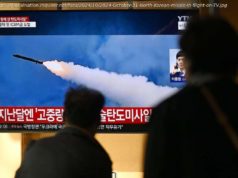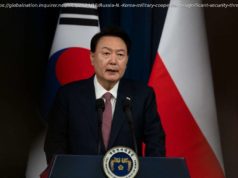There has been a looming threat of a World War 3 outbreak in the Korean peninsula these past few months due to the deteriorating relationship between U. S., North Korea, and Russia. However, the…
There has been a looming threat of a World War 3 outbreak in the Korean peninsula these past few months due to the deteriorating relationship between U. S., North Korea, and Russia. However, the recent incidents in Syria have elevated the fears of WW3 in the war-torn country.
A U. S. aircraft shot down an Iranian-made drone that attacked the coalition forces on Thursday. This is the first time that pro-Syrian forces have fired at the U. S. led coalition forces. However, this was the second time in past three days and third time in recent weeks that U. S. led coalition forces have bombarded pro-Assad forces.
The official spokesperson, Army Col. Ryan Dillon said that the drone was shot down after it dropped ammunition close to a location where the partner forces were being trained to fight Islamic terrorists. He added that the drone was similar in size to the MQ-1 Predator and it still contained weapons when it was struck down.
It is speculated that the drone was being controlled somewhere north of Al Tanf inside Syria and was meant to attack the coalition forces. There were no injuries reported in the drone attack. Earlier in the day, U. S. warplanes destroyed two armed vehicles that had entered the deconfliction zone and were headed towards the Al Tanf base.
Al Tanf is on a strategic highway that connects the Damascus to Baghdad. Experts believe that the aim of Iran-backed militias is to secure the strategic location and establish a corridor from Syria to Iraq and to Iran. U. S. has clearly convened its intentions to prevent the Syrian government forces from securing the area.
The U. S. forces in a mutual understanding with Russia had set up a deconfliction zone to prevent direct conflict between coalition forces and pro-Assad forces. The zone, which earlier applied only to airspace, now also includes ground territory. The deconfliction zone has been used ever since the pro-Assad forces reached the region.
The particular area has become the center of attraction where there is a possibility of U. S. forces coming in direct conflict with Iran-backed militias or the Syrian troops. The Lebanese group, Hezbollah also has a significant presence in the region. Even though U. S. has maintained that its goal is to fight ISIS and not the Syrian government, experts believe otherwise.
Amir Toumaj, a research analyst with the Foundation for Defense of Democracies, a Washington-based policy center, said in a statement that it appears that U. S. strategy is to deny Iran that land corridor. The central command has also said that it will take appropriate measures to protect American forces.
Hezbollah issued a warning that they would strike Americans if they crossed any “red lines.” As reported by the New York Times, they did not define what the red line meant, but it is evident that it is only a matter of time before U. S. led coalition forces will be in direct conflict with pro-Assad forces backed by Iran and Russia, giving rise to the possibility of World War 3 .
Meanwhile, diplomatically Trump’s statement can further worsen the situation. During his visit to Saudi Arabia he said, “all nations of conscience must work together to isolate Iran.”
Experts believe that Trump’s statement indicates that he has taken a different stand than Obama, who refrained from taking sides in the Saudi-Iran rivalry.
Donald Trump’s response to the recent attacks on the parliament of Iran also raises some serious questions. When world leaders were expressing solidarity, Trump preferred to rub salt in Iran’s wound. He issued a statement which blamed Iran for sponsoring terrorism and falling victim to it. Notably, the attacks were carried out by ISIS, who is also Iran’s enemy.
President Donald Trump’s statements are not seen as a welcome step in improving U. S. relationships with Iran, North Korea, and Russia. Additionally, the U. S. policy to prevent Iran from controlling the region around At-Tanf could see more direct conflicts between American forces and Pro-Assad forces, including Russians and Iranians, which could even lead to the outbreak of World War 3.
[Featured Image by DOD/Getty Images]






